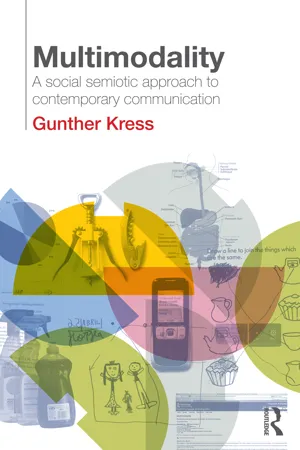
- 214 pages
- English
- ePUB (mobile friendly)
- Available on iOS & Android
About this book
The 21st century is awash with ever more mixed and remixed images, writing, layout, sound, gesture, speech, and 3D objects. Multimodality looks beyond language and examines these multiple modes of communication and meaning making.
Multimodality: A Social Semiotic Approach to Contemporary Communication represents a long-awaited and much anticipated addition to the study of multimodality from the scholar who pioneered and continues to play a decisive role in shaping the field. Written in an accessible manner and illustrated with a wealth of photos and illustrations to clearly demonstrate the points made, Multimodality: A Social Semiotic Approach to Contemporary Communication deliberately sets out to locate communication in the everyday, covering topics and issues not usually discussed in books of this kind, from traffic signs to mobile phones.
In this book, Gunther Kress presents a contemporary, distinctive and widely applicable approach to communication. He provides the framework necessary for understanding the attempt to bring all modes of meaning-making together under one unified theoretical roof.
This exploration of an increasingly vital area of language and communication studies will be of interest to advanced undergraduate and postgraduate students in the fields of English language and applied linguistics, media and communication studies and education.
Frequently asked questions
- Essential is ideal for learners and professionals who enjoy exploring a wide range of subjects. Access the Essential Library with 800,000+ trusted titles and best-sellers across business, personal growth, and the humanities. Includes unlimited reading time and Standard Read Aloud voice.
- Complete: Perfect for advanced learners and researchers needing full, unrestricted access. Unlock 1.4M+ books across hundreds of subjects, including academic and specialized titles. The Complete Plan also includes advanced features like Premium Read Aloud and Research Assistant.
Please note we cannot support devices running on iOS 13 and Android 7 or earlier. Learn more about using the app.
Information
Index
- abstraction 105
- action 116, 117, 119–20, 123, 162, 188
- Adami, Elizabetta 184–97
- aeroplane cabin staff 71–2
- aesthetics 28, 139, 172–3
- affect 43, 59, 77, 83, 109, 146, 177
- affordances 27, 76, 80, 92, 102
- design 137, 143
- diary genre 94–5
- language 84
- materiality 82–3, 86, 104, 157
- mobile convergent devices 185, 186–8, 194, 195–6
- modal preferences 83
- modes as technologies of transcription 96
- multimodal representation 97
- orchestration 161
- participatory 144
- textbooks 48
- age 23
- agency 59, 66, 107–8, 184
- choice 185
- design 132–3, 134
- knowledge production 143
- learners 145
- selection from options 193, 194
- semiotic 188
- ambiguity 60
- amelioration 74
- analogy 70, 71, 156–7
- aptness 55, 71–2, 143, 156, 162
- naming 103–4, 105
- orchestration 157
- resources 157
- salt and pepper 67, 68
- arbitrariness 63, 64, 65–6
- architecture 110–13, 124,...
Table of contents
- Cover
- Endorsements
- Half Title
- Title
- Copyright
- Dedication
- Contents
- List of illustrations
- Preface
- Acknowledgements
- Chapter 1 Where meaning is the issue
- Chapter 2 The social environment of contemporary communication
- Chapter 3 Communication: shaping the domain of meaning
- Chapter 4 A social-semiotic theory of multimodality
- Chapter 5 Mode
- Chapter 6 Meaning as resource: ‘naming’ in a multimodal social-semiotic theory
- Chapter 7 Design and arrangements: making meaning material
- Chapter 8 Multimodal orchestrations and ensembles of meaning
- Chapter 9 Applying the theory: learning and evaluation; identity and knowledge
- Chapter 10 The social semiotics of convergent mobile devices: new forms of composition and the transformation of habitus
- References
- Index